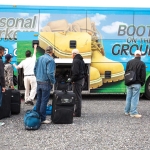Recruiting fruit pickers through the H-2A foreign guest worker program is a better alternative than just hoping workers show up at the farm, orchardists in north central Washington say.
But growers who aren’t large enough to employ their own human resources staff should consider having a third party process the workers.

Mark Stennes
Mark Stennes, who farms with his brother Kevin at Pateros, and Sam Godwin, a small grower with orchards in the Tonasket area, have both obtained foreign guest workers through the Washington Farm Labor Association (WAFLA), which handles 80 percent of the H-2A contracts in Washington State.
“Unless you’re a vertically integrated operator, it’s not possible to do it alone,” Stennes said. “I would not dive into it without a third party.”
WAFLA can help small growers to reduce the financial burden of using the H-2A program by sharing workers with other growers. (Read “Sharing workers saves costs.”)
In the past decade, the number of H-2A workers coming to Washington has increased from fewer than 500 to more than 9,000. Nationally, more than 100,000 H-2A workers are employed annually.
The largest per-capita H-2A usage in Washington is in Okanogan County, where Stennes and Godwin (and Gebbers Farms, one of the largest H-2A users in the country) are located. Okanogan is the northernmost county in central Washington, bordering Canada, and has a smaller supply of migrant workers than counties further south.
Difficult
Stennes is a fourth-generation grower whose family has 550 acres of orchard with 25 fruit varieties in a number of locations and at a range of elevations. Godwin has 125 acres of apples, pears, and cherries in blocks ranging from 10 to 40 acres scattered over a 15-mile radius. During the last decade, it’s become increasingly difficult for them to find enough workers.
The Stennes family had two H-2A contracts last year, the first of which was for 26 workers for the full season, from June to October. The second was a shared contract, under which 28 additional workers began working for another employer in the Columbia Basin and then moved to the Stennes ranch in Pateros in late July. About a third of their cherry pickers and half their apple pickers were H-2A guest workers last season, Stennes said.
Godwin said he typically needs about 40 cherry pickers and 20 pickers for apples. Two years ago, he had a very light cherry crop and only three people showed up to pick. He got the crop harvested with his year-round workers, but it was a wake-up call, he said.
Last year, he checked into the H-2A program and found that he could share workers with another farmer. So, he partnered with his parents, who also have orchards. Together, they brought in 28 H-2A workers for their combined 200 acres.
WAFLA helped them structure the contract so that the workers could move between farms as needed and keep busy the whole season long. The crew arrived for cherry harvest in mid-June and left in October after the apples were picked. The association also helped them to train the foremen before the H-2A workers arrived.
Housing
One of the biggest barriers to using the H-2A program is the need to provide housing for the workers, Stennes said. His family remodeled their existing farm worker housing. The estimated cost of providing new housing is $6,000 to $8,000 a bed, he said.
Instead, the Stennes family hired a building contractor and invested $2,000 to $3,000 per bed to upgrade their housing and bring it into compliance with regulations. Next year, they’ll build more housing and hope to have beds for 140 workers eventually.
As well as being obligatory for H-2A workers, housing also helps attract domestic workers from California, he said.
Godwin rented 28 beds for his workers last year at a facility operated by the Housing Authority in Oroville, so he didn’t need to bring his on-farm housing up to standard.

Sam Godwin
Asked if it would be worthwhile for a grower who doesn’t have housing to build it in order to use the H-2A program, Stennes said it’s more expensive to leave a crop unharvested or pick it too late than to use the program.
“The answer for me is yes,” added Godwin, who will build his own on-farm housing this year. “I can’t imagine trying to farm without the program, mainly because of our location. Not knowing if you’re going to be able to pick is pretty tough when you’ve put all the money into your crops. We have ideas of continuing in farming and, in the area where we live, it’s the only way we see to move forward and attract the labor we want.”
Although renting beds worked well last season, the housing was too far from his orchards. He had two 14-passenger vans to transport workers between the housing unit and the orchards—a journey of 45 minutes to 1 hour—at the start and end of each day.
This meant that one of his experienced workers ended up being a bus driver for an extra two hours a day, which was particularly difficult during harvest. “It’s a lot of extra burden and cost,” Godwin said.
The workers would rather be closer to where they’re working, he said, and on-farm housing will reduce his costs for van drivers and fuel. He thinks that, in the long term, the cost of building will be almost the same as for renting.
However, the grower still must transport workers to places they need to go, such as the bank, grocery store, or church. “While they’re here, they’re yours,” Godwin said. “Anywhere they want to go, we’ll try to work with them. We bus them around a lot. They’ll work hard for you if you treat them right.”
Training
During the first season in the H-2A program, the grower should count on spending a lot of time training workers and identifying which workers they would like to return the following year, Godwin said.
“The H-2A guys are happy to be there. The majority of people want to be there and want to work and do it well,” he said. “But a lot of them don’t have a lot of experience, even though they say they do. There’s far more training that has to happen initially. Plan on spending more time explaining what you want. We hope, as we continue with the program, we get the same people back who have been trained.”
Godwin said growers should make sure the H-2A contract correctly spells out the jobs the workers will be required to do—whether it’s summer pruning, mowing, or building trellises—because the workers know what the contract says and there are different wage rates for different jobs.
“It makes a big difference for administering it all season long, and it’s much easier for you if you have a contract that fits what you’re planning to do on your farm and how you’re planning on rotating your people,” he said.
Stennes expects it to be a three- to five-year process to weed out the less productive workers and get the core group of workers that the grower is looking for.
Both years that Stennes employed guest workers, there were unforeseen circumstances that WAFLA was able to help out with.
“WAFLA and other agencies are just a call away,” he said. “We’re learning the program as we go. With a third-party group to help, it’s very doable.” •
ONLINE
For more information, check the website at wafla.org/guestworkers








Seems strange. Over the border fruit picking is actually a very popular job for students and youth here on working visa programs. It is actually considered one of the more desirable farm jobs, while in the US growers are apparently using the H2A program to fill them. It doesn’t make sense. What is so different about the US? You guys seem to favour Mexican workers while you have people in your own backyard, or even Canadians, that you could hire instead. Glad I am not an American after reading this.
The difference is that British Columbia growers harvest fewer than 5 million boxes of apples compared with 150 million harvested in Washington. Also, Washington orchards are not typically near populated or tourist areas.
As you stated over 150 million boxes and I’m sure they need a lot of workers to package the apples. I worked for Gebber Farms a whole year or I should say when ever they needed me. They also refuse to pay over time to the general warehouse female workers. Gebber Farms stated they are a small fam business when I asked why over time was denied especially after working over 40hours. I quit working but for many women who have dedicated their life to the company deserve income. The year I worked full time apple harvest I made roughly &13,000